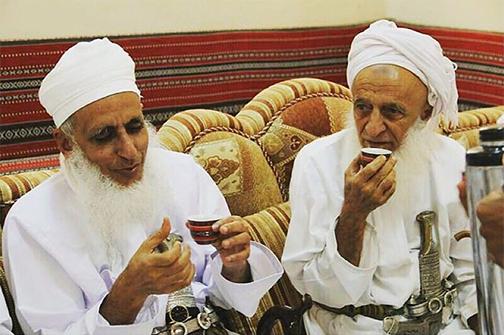“Allahu akbar wa lillahi al hamd!” cried the imam, sweeping his hands up to signal our response.
“Allahu akbar wa lillahi al hamd!” we bellowed. The men around me were pointing their camera phones at the imam to capture what was happening, and many were hugging one another in frenzied celebration.
I was in the sabla, a community room attached to the mosque next to my apartment in Muscat, and had just witnessed a conversion — or reversion, as many people like to say — to Islam. The guest speaker of the night, an Algerian-Australian man with a long beard named Sheikh Sufjan, prompted the soon-to-be-reverts with the shahadah, the Muslim profession of faith, and the joyful Allahu akbars erupted after they repeated the last line. The imam of the mosque, Sheikh Ahmed, was visibly giddy before the conversion and misty-eyed afterward, looking legitimately relieved that four newly-minted Muslims had just joined 1.2 billion brothers and sisters around the world, and would join the remainder of all Muslims in heaven.
Sheikh Ahmed is my next-door neighbor, and has been “giving me da’wah” since we moved into our apartment across the hall from his. Da’wah means a call or invitation, and is the Islamic equivalent of friendly proselytization. For Sheikh Ahmed and me, it started with general good-neighborliness — he would knock on our door to bring us sweets, offering use of his furniture or car, putting himself at our disposal for anything we needed — it continued when he began inviting me into the mosque.
Our apartment building is right next to a jamaa masjid, a large mosque that serves as a social center of the neighborhood and host for congregational Friday prayers. Both our building and the mosque were built by the Ministry of Awqaf and Religious Affairs in 2015, and we were the first tenants in our unit. The apartment building is a waqf[1] — a type of revenue-generating Islamic endowment to fund religious and charitable initiatives — and aside from being right next to the mosque and the imam’s parsonage, there’s a Qur’anic school for children on the ground floor.
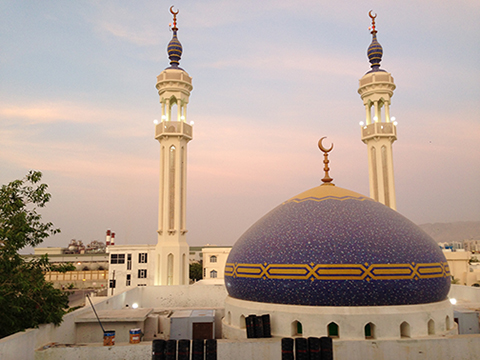
When I first met Sheikh Ahmad, he didn’t fit into my conception of what an imam of an Omani mosque would look like. He didn’t wear Omani dress, or the dress of an Ibadi sheikh, and his Arabic accent was decidedly non-Gulf. Eventually, I deduced he was Egyptian — during Friday prayers, he wore a red tarboosh with white turban wrapped around it — the distinguishing headgear of scholars from Cairo’s Al-Azhar, arguably the most renowned and respected institute of Islamic learning in the world. Over time, I’ve gotten to know Sheikh Ahmad fairly well, and even attended his brother’s wedding at the Egyptian club. As an Egyptian, and as a graduate of Al Azhar University, Sheikh Ahmad is a Sunni — despite leading prayer for dozens of Ibadi congregants every day.
Islam is often seen through the binary lens of Sunnism and Shi’ism throughout the world, with concessions occasionally granted to Sufism, the umbrella term for a variety of mystical, folk, and monastic groups. Within this binary, people often hold or repeat pretensions of pan-sect unity or homogenous thought within the sects (e.g. “We need to build Sunni trust in Iraq”). As with any essentialist stance on the human experience, to reduce people’s beliefs or actions solely to their sect is a mistake.
As neither Sunni nor Shia, Ibadism exists outside of the commonly-held binary, although, in fairness, Ibadis only make up about one per cent of all Muslims. Oman has the largest concentration of Ibadis in the world , with much smaller populations existing on Djerba Island in Tunisia, Jebel Nafusa in Libya, the Mzab Valley in Algeria, and Zanzibar. They were early outcasts of what is now considered Muslim orthodoxy, and were as such “pushed to the margins of the Islamic Empire”[2] in these remote areas, far from the centers of political and economic power in Mecca, Baghdad, Cairo or Damascus. As such a small minority today, they are either unknown or a curiosity to most Muslims and many scholars of Islamic thought.
Top religious authorities in the Sunni tradition disagree on how Ibadis should be regarded. The official fatwa-issuing body of Saudi Arabia, which, for better or for worse, is seen by many as the leader of the Sunni world, has said that it is not permissible to pray behind Ibadis, as they are a “deviant sect.” Al-Azhar University, however, has taken a more conciliatory tone, educating its students in the history of Ibadi thought and pushing a broad-minded approach to the other sects.[3] Sheikh Ahmad lives this moderation daily in the mosque — as do Omani Sunnis who contradict the Saudi fatwa, praying behind Ibadi imams across Oman.
The official religion of Oman is just “Islam,” but Ibadi Islam is the de facto state religion: His Majesty the Sultan, the Grand Mufti, and the Minister of Awqaf and Religious Affairs are all Ibadis, and the largest and most prominent mosques all have Ibadi imams. When His Majesty Sultan Qaboos prays in a mosque, he’s invariably flanked by his cabinet and other top government officials — most of whom are Ibadi, and some of whom are Sunni — but all of whom stand beside one another in slightly different postures of prayer. How to perform salat, or prayer, is the most outwardly visible separator of Ibadis and Sunnis. Indeed, prominent scholar of Ibadism Valerie Hoffman has said that most Omanis she has encountered “associate Ibadism mainly with the differences in prayer regulations.”
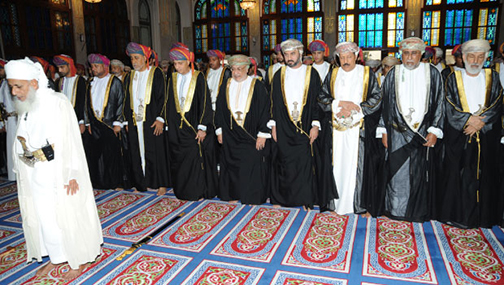
Ibadis pray in the standing position with their hands at their sides, whereas Sunnis fold their hands over their chest or stomach. Likewise, Ibadis keep their hands at their sides during while saying Allahu akbar, while Sunnis raise their hands to their ears. At the mosque beside my house, the members of my community neatly organize themselves in rows to stand shoulder-to-shoulder in these varied postures, praying and coexisting together.
Omanis are certainly aware of and fearful of the intra- and international sectarian conflicts across the Middle East, and have managed to build and maintain a country that seems to serve as the exception to the rule. In this sense, Oman can serve as a useful case study of how it might be possible to prevent, or at least suppress, sectarian ideology.
Most Omanis tend to gloss over the differences between schools of thought in favor of accentuating similarities. Discussions of sect are often had in hushed tones, or minimized in a way that belies the harsh reality in other parts of the world (e.g. “There is no difference, we are all Muslims” is a common refrain.) In fact, it widely perceived as illegal to ask someone what sect they belong to, as it’s almost always perceived as an insult and, under the law, an “abuse to [a person’s] dignity.”[4] Children are taught from a young age to not inquire about the sect, tribe, or mother tongue of others — some of the many interconnected identity markers in Oman. In history books, the historical sectarian and tribal conflicts are played down in favor of a unified pan-Islamic and pan-Arab history.
This is all by design. Scholars Marc Valeri and Dale Eickelman have said that despite Ibadism being the sanctioned state religion, the government promotes a top-down “generic” version of Islam. Omani religious authorities “have sought to dilute the differences between Ibadi and Sunni schools of Islam,” writes Marc Valeri.[5] Part of this is to avoid the pitfalls of sectarianism, and part may be to avoid conflicts that might stem out of the tumultuous history of the early Ibadi tradition.
Western academics agree that Ibadis are ideological descendants of the khawarij, or Kharijites, meaning literally, “those who went out,” referring to a critical juncture in early Islamic history that also caused the Sunni-Shia split. That said, Omanis often take exception to be associated with khawarij — the term is nowadays mostly associated with the Islamic State — in that they call anyone but themselves khawarij, and “mainstream” Sunnis sometimes call ISIS khawarij. Which explains why, on multiple occasions, I’ve seen Omani audience members confront Western scholars at conferences for not adequately distinguishing khariji doctrine from the Ibadi tradition. Even so, the Ibadi and Kharijite movements have a shared historical origin that cannot be ignored.
The assassination of the third caliph after Muhammad, ‘Uthman, created a power vacuum that led to the first fitna, between those who thought ‘Ali should be caliph, and supporters of Mu’awiyah.[6] Their respective armies met at the Battle of Siffin, and after some of Mu’awiyah’s supporters attached Qur’ans to the end of their spears, ‘Ali agreed to arbitration of the conflict.[7] Some of ‘Ali’s supporters disagreed with the idea of arbitration, and “went out” from his camp, and were later called khawarij. Ali’s supporters would become Shi’a, and Mu’awiyah’s supporters (and the successive Umayyad Caliphate) Sunni. The khawarij were eventually hunted or died out, save for the Ibadis.
Early Kharijites were obsessed with the notion of piety, and some of the Prophet’s most pious companions were in the ranks of the khawarij.[8] The movement had its own internal divisions, although early adherents agreed that the caliph should be an exemplar piety chosen from the community at large, not from the Quraysh tribe (as Sunnis believed) or the Prophet’s direct relatives and descendants (as Shi’a believe). This notion remains a critical element of Ibadism — that the Imam should be elected from the community — and is why Ibadis sometimes still refer to themselves as ahl al-shura, or people of consultation.[9] Unlike the Ibadis of today, however, the early khawarij were quick to call other early Muslims sinners and apostates, waging a violent campaign against both sides.
In the first century after the death of the Prophet, an Iraqi scholar named Abdullah Ibn Ibad distanced himself from the more bloodthirsty elements of the khawarij and gained a number of followers in Basra.[10] Ibn Ibad is a largely apocryphal figure — we mainly know that he was a trusted transmitter of hadith, and was thus recognized for his integrity. His disciples would continue to emphasis the importance of integrity, piousness, and the avoidance of sinful acts, but took a more conciliatory tone toward outsiders than the khawarij they split off from. And although Abdullah Ibn Ibad lent his name to Ibadi tradition, it was his follower Jabir bin Zayd from a small village in the Omani interior that who become the first Ibadi Imam in a long history of rising and falling Imamates of Oman.[11]
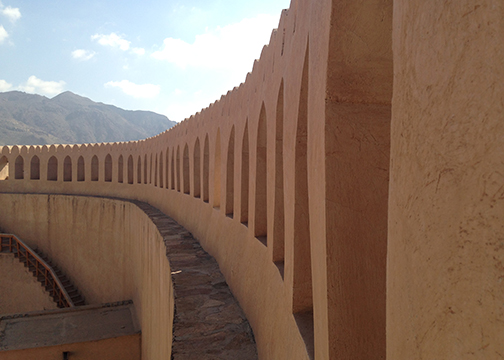
The ring of interior villages of Nizwa, Rustaq, Bahla, Jibrin, and Nakhl are all centered around massive forts, each a relic of centuries of conflict that typified medieval and early modern Ibadi history in Oman. Ideologies of religion and governance competed with one another, manifested most memorably in the doctrinal disputes between the imams in Rustaq and Nizwa, and the ebb and flow of dynastic versus elected leadership of the Imamate.
In all of the villages listed above, the forts have been beautifully restored, and are open to the public. Busloads of tourists and schoolchildren shuffle through the stairwells and passageways of the forts, that invariably showcase the Imam’s quarters, the Qur’an school, barracks, a prison, and trap doors to stave off marauders. Each fort is spectacular and breathtaking in appearance, but one gets the sense that if you’ve seen one, you’ve seem them all — they are all filled with the same memorabilia that showcases a sanitized and eternal view of Omani history, props to “a past [young Omanis do] not recognize or remember,” wrote the scholar Mandana Limbert, upon visiting Jibrin castle with an Omani family.[12]
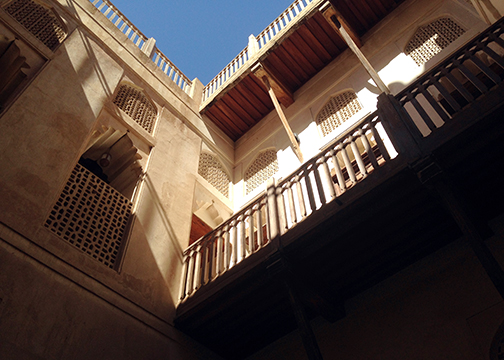
She recalls the children of the family seeking out the removable stair planks that intruders would fall into and holes in the ceiling where boiling date syrup would be poured on the heads of unsuspecting victims, violence that to them “seemed too distant to be real.” But the past is very real, and not so distant.
The last Ibadi Imam, Ghalib bin Ali Al Hinai, died in exile in 2009. The month he died, I was staying at an apartment in Nizwa, just steps away from his former residence and capital, Nizwa Fort. The fort was originally built in 1639 by another Ibadi Imam, Sultan bin Seif al Ya’arubi, and its enormous central tower looks like something out of the story book, dwarfing the bustling souq clustered at its base.
Emily and I scaled the steps of the tower this spring, and craned our necks up at the Omani flag that flies high above the fort. From the tower, it’s easy to see why Nizwa has been the heart of the Ibadi interior for centuries: it sits in a natural basin surrounded on almost all sides by small mountains, and on its northern side flanked by Jebel Akhdar, an enormous stone massif that dominates the landscape of the interior. The Nizwa school of thought beat out the Rustaq strain, and is said to have been the more tolerant of the two creeds. Despite this, last Imam and his faithful Ibadi followers waged a war against His Majesty’s father Sultan Said bin Taimur in the late 1950’s. Imam Ghalib was buoyed by local Ibadi tribes and supported in part by the Saudis, who saw the Sultans of Muscat as British proxies and rivals of Wahhabi ambition.
The British trained and aided the Sultan’s forces, establishing the Muscat Levy Corps, the all-Baluchi first standalone regiment of Oman. The Sultan’s forces and their British enablers chased the Imam’s forces up Jebel Akhdar, which would lend its name to the war, and the Imam ultimately recognized defeat after Nizwa Fort and several interior villages were bombed, leading his followers to recognized the superiority of British firepower to their muzzle-loading rifles. The interior at that time was one of the most isolated and remote places on earth — just a few years earlier, British explorers had steered clear of the entire region lest they face certain death at the hands of “zealots.” Even though the Sultanate was victorious over the Imamate, loyalty cannot be flicked like a switch overnight.
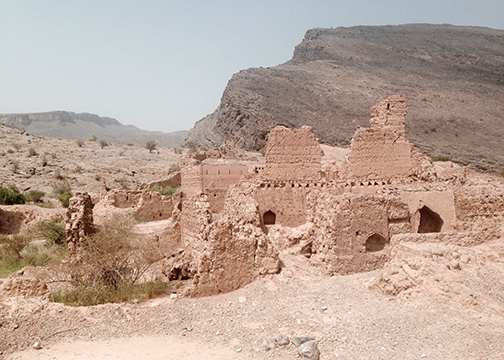
The legacy and history of the interior Imamate runs parallel and distinct to that of the coastal Sultans. Until Sultan Qaboos changed his homeland’s name in 1970, the country was known as Muscat and Oman; Muscat being the coastal ports, and Oman being the mountainous interior. Even today, some people still refer to the interior districts as “real Oman,” or even just Oman, a contrast to cosmopolitan Muscat.
Imam Ghalib was invited back to Oman by Sultan Qaboos, but never accepted the invitation. Instead, he died in exile as a quiet guest of the Saudis, and his passing went without fanfare or public acknowledgement in Oman. One imagines that this was a relief to the powers-that-be. In 2005, while he was still living, dozens of prominent Ibadi academics, sheikhs, and tribal leaders were arrested under the charge of trying to reestablish the Imamate.[13] Much like today, the arrests came at a time of heightened public anxiety over terrorism, as the wars in Iraq and Afghanistan raged and bombings shook the cities of London and Madrid. After their sentences were announced, all charges were dropped and the offenders pardoned personally by Sultan Qaboos.
Taking the high level of comfort Omanis enjoy today, and seeing that Sultan Qaboos successfully and gracefully weathered the Arab Spring, it seems unlikely that an Ibadi Imamate would be carved out of the Sultanate’s interior in the 21st century. Even so, the propensity for revivalist movements legitimizing themselves with historical arguments is an all-too-common occurrence today, it only takes a dedicated few to spark unrest.
Doctrinally, revivalists wouldn’t have to look far for an ideological basis to reestablish the Imamate. After all, Ibadis view themselves as the “true” Muslims; in their own eyes they are ahl al-istiqama, or people of the sirat al mustaqeem, the straight path from which others have deviated, although they have since lost the militancy originally attached to this self-conception. Moreover, a central tenet of Ibadism is the obligation to overthrow unjust rulers (the original khawarij saw ‘Uthman, ‘Ali, and Mu’awiyah as unjust), and establishing a just Imamate is mandatory if someone is deemed “unjust.” Better yet, there is an Imamate for each type of political climate Ibadis might encounter. There is the “declared” Imamate, which is the pinnacle, the Imamate as it should exist. The “defensive” Imamate, which is in a state of war; the “activist” Imamate, a nascent system in the process of establishing its rule; and finally, the “hidden” Imamate.[14]
Imama al-kitmaan, or the “hidden” Imamate, is said to exist whenever establishing the Imamate is otherwise implausible or untenable. In order to announce the establishment of the Imamate and bring it into the “activist” phase, the pious only need “forty men willing to lay down their lives” for the cause, so says Ibadi canon.[15] In an era of transnational jihad, rounding up forty zealots doesn’t seem like too difficult a task.
After years of engagement with the Islamic world, a Western archetype of what Islamic zealotry looks like has emerged: long beards with a short mustache, constant covering of the head with a cap or turban, pant and robe-hems above the ankle. In combination with one another, these style choices might scream Salafist or even dangerously extreme in other countries, but they are common, if not entirely within the norm, in most of Oman. Long beards and short dishdashas are an every day sight among Omani Ibadis — and are rooted in the Ibadi principles of closely following the actions and words of the Prophet Muhammad.
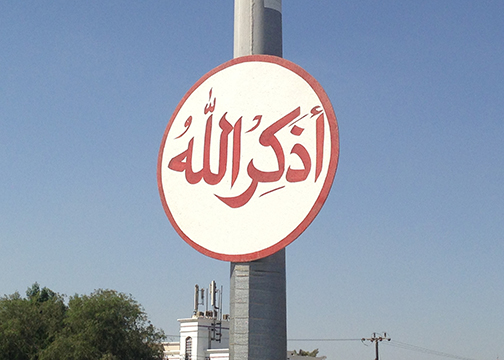
But it Oman, I’ve often found that the people who most look like mutawwa — meaning religious police, but slang here for hyperconservative — can be the most friendly. The first Ibadi sheikh I ever met had the longest beard I’d ever seen in real life, its costume-like shape falling below his sternum, with a shock of white beneath his chin matching his white turban and (short) white dishdasha. But Sheikh Khalfan al Esry was the farthest thing from a zealot; he was one of those people who seemed to transcend religions — I’ve meet priests and rabbis and monks who have the same temperament — radiating sincerity, joyfulness, and intention.
My Arabic teacher, who also fits the outward appearance of conservatism, once reached through my car window and turned off the radio, saying the istighfar (“I seek refuge in God”) and telling me he didn’t want to hear music, which would’ve been haram. Despite this, he had an otherwise effervescent and gregarious personality. Another time, I was sitting on an Oman Air flight between two employees from the Ministry of Awqaf, who again fit the bill, but who warmly told me that they would pray for my safety on the flight and eventually invited me to their date plantation in the interior.
Ibadism is by nature puritanical, with many Ibadis going beyond what is halal and haram and striving to live their daily lives in strict accordance with that which is mustahhab (recommended) and avoidance of that which makruh (unfavorable). Outward appearance is just the tip of the iceberg in this way of life that encompasses all forms. Right now, we live in an ideal world where Ibadism is puritanical but not absolutist, and the most peaceful and harmonious elements of the religion seem to shine through.
Part of this is due to the union of Ibadi and Sultanic ideologies forged by Sultan Qaboos. While he makes no claim of religious authority, part of his legitimacy lies in the overthrow of his unjust father orchestrated during the Dhofar War — again, the ouster of unjust rulers is foundationally obligatory in Ibadism. And while he did not establish an Imamate after the ouster of Said bin Taimur, Qaboos bin Said is a descendant of the Ibadi Imam Ahmed bin Said Al Busaidi, the progenitor of the unbroken Al Busaidi dynasty that began as an elected Imamate, but eventually became a dynastic Sultanate.
In addition, Sultan Qaboos has wisely incorporated allusion to Ibadism in his government. The quasi-parliametary Majlis Al Shura, or Consultative Council, is a direct reference to Ibadis as the ahl al-shura, or “people of consultation.” That Qaboos’ reign is known as al-nahda, or “the renaissance,” is another reference to the Ibadi concept of a nahda of the Imamate’s reestablishment after a period of strife. On top of this, Sultan Qaboos has persisted in a path of inclusivity and forgiveness; aside from his annual pardonings and “who’s who” of Omani tribes in the cabinet, the last Imam’s son, Khatab bin Ghalib bin Ali Al Hinai, was appointed by the Sultan to the upper house of parliament.
These nods to Ibadi history and principles tempered with the coastal cosmopolitanism of the Al Busaidi Sultans are what has given us Ibadism as practiced today — a “moderate” Islam, as it is so often called. Ibadism as “a moderate form of Islam” has rightfully been accepted by observers, visitors, and even by Omanis themselves because it is the reality of Ibadism today. But this moderation has only existed in earnest for the past half-century, and was characterized by war, extreme conservatism, and isolationism for the hundreds of years leading up to Sultan Qaboos’ reign, when the switch was flipped to promote the sect as “generic,” inclusive, and peaceful.
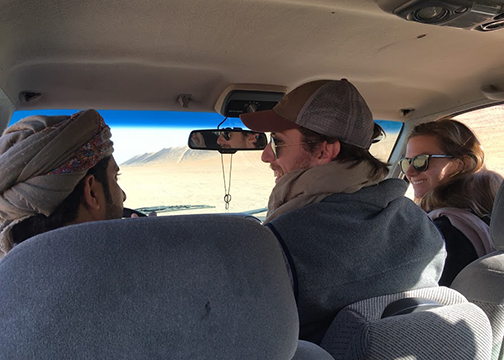
And I benefit from this moderate Ibadism, as I haven’t had a single concern about religiously motivated violence since I’ve been here. The outside door to our apartment building is always propped open, and doesn’t even lock if we tried. I’ve hitchhiked in Omani trucks and entered strangers’ homes in the deepest parts of the interior without batting an eye. In a time where the hinterlands of other Arab countries are almost certainly a “no-go” for Westerners, this feels like a magical time to be alive in Oman.
Back in my local mosque, I’ve been wondering whether or not Sheikh Ahmad’s da’wah is working, and dutifully attending the open lectures after maghrib prayer on Friday nights. At a recent one, Sheikh Ahmad repeated a platitude about Islamic unity and sects being irrelevant, which prompted a question from a congregant behind me about ISIS, to the effect of “How can they kill other Muslims and still call themselves Muslim?”
At first, the question was dismissed, but the questioner persisted and the conversation quickly escalated, with Sheikh Ahmad, the questioner, and another sheikh in the audience talking over one another. All of them seemed conscious of my presence as the only non-Muslim and Westerner in the mosque, and it embarrassed me that they might have felt the need to differentiate themselves from ISIS so fervently for my sake.
As their voices continued to rise, Sheikh Ahmad began speaking in English, looking directly at me with his finger raised, his voice hoarse with desperation.
“We are against the killing, the Omanis! We are against the killing!” yelled the sheikh, an Egyptian Sunni graduate of Al Azhar, speaking on behalf of Omanis.
Beside me, a young Omani who was had idly been playing with the hem of his dishdasha looked up and nodded.
[1] Waqf is the singular of awqaf, as in Ministry of Awqaf and Religious Affairs
[2] Valerie Hoffman, The Essentials of Ibadi Islam (2012)
[3] Saudi Fatwa No. 6935 and http://www.al-monitor.com/pulse/originals/2015/06/egypt-azhar-curriculim-revise-religious-discourse-extremism.html#
[4] Sultanate of Oman Basic Statute of the State (1996), Article 31
[5] Marc Valeri, Oman: Politics and Society in the Qaboos State (2009).
[6] In my first newsletter, I incorrectly said that the khawarij broke off immediately after the Prophet’s death, during the reign of the first caliph Abu Bakr. I have since learned that it was after the third caliph ‘Uthman. That said, supporters of ‘Ali maintained that he, not Abu Bakr, should have been the first caliph.
[7] Hoffman, Essentials
[8] Hoffman, Essentials: 11
[9] Valeri, Politics and Society: 5
[10] John C. Wilkinson, Ibadism: Its Origins and Development
[11] Ibadis use the term Imam instead of caliph although the two are interchangeable in terms of being the leader of the umma, or community of Muslims
[12] Mandana Limbert, In the Time of Oil (2010): 25
[13] https://cy.revues.org/1472
[14] Lecture by Valerie Hoffman in Abu Dhabi, February 2015
[15] Ibid

